Controversial snacks and mild-mannered symposium
July 7, 2007
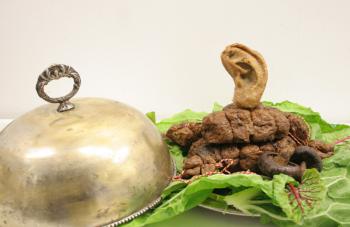
Wandering Banquet’s wheat meat piéce montée was not just another secret ingredient. You hear me talkin’?
Dutch fire marshalls the world over will be unhappy to read that last Friday’s Food, Art and Science symposium at the Centraal Museum in Utrecht was filled way beyond capacity. Lab meat is apparently all the shizz and more than 100 people showed up, including film crews accompanying the journalists who invariably got their facts skewed.
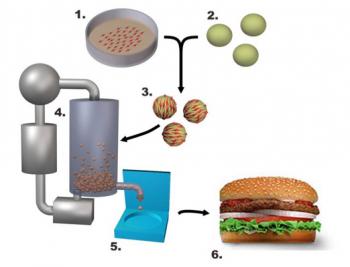
Illustration of a possibility used entirely w/o permission
Prof. Henk Haagsman, meat scientist from the U of U kicked off the event with an account of the ecological impact of our current modes of meat production. If your secret symposium dream was laced with cat fights, bitch-slaps, and shoes hurled hard (as was mine), Haagsman’s unassuming demeanor was nothing short of unnerving. He is a perfect spokesperson for an industry-to-be already supported by a consortium that counts Sara-Lee Foods, Smithfields and Stegeman among its members. He can explain the technical ins and outs of lab meat in a way that any layman could understand. But in the end, Haagsman is a scientist not an evangelist, and points out that he sees lab grown meat as merely another possible alternative to meat grown meat. And who can argue with that? (Yeah, you in the front…)
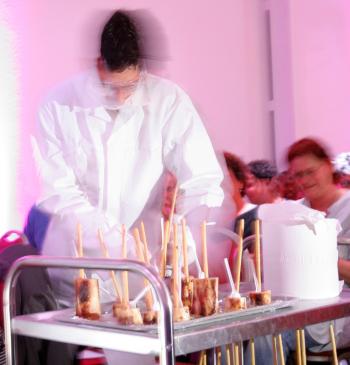
Bone marrow transplant, first snack of the evening.
After each speaker, Wandering Banquets rolled out a controversial snack. First up was a hunk of roasted cow bone brimming with melting marrow, sprinkled with sea salt and gored with a bread stick. Although I call myself an environmental vegetarian, I can’t tell you how fast I tucked into that thing, wondering all the while why I don’t eat marrow every single day of my life, and wondering even more, when exactly I had become my own bone-sucking mother. Waste not, want not, gimme that bone, Bone. Funnily, the potentially squeamish in the audience had no idea what they were eating and only found out when I spilled the beans at the end of the evening. The guy sitting behind me, clearly macroneurotic, thought it was disgusting (not true) and ‘very fatty’. Yeah, there may be a tiny bit of fat inside that bone.
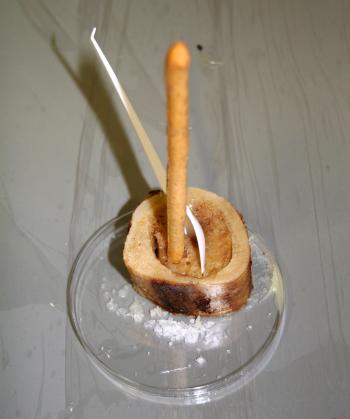
Roasted bone marrow and sea salt w/bread stick
Dr. Cor van der Weele from the U of Wageningen was the designated ethicist and I really appreciated her using examples from contemporary art (I mean bio-art) to explain the moral dilemnas of this subject. After pointing out the role of ethics in technology, Dr. vd Weele took a three-pronged approach to analyse the moral terrain and very helpfully came up with three different conclusions. Of all the speakers, her presentation left me with the most questions for further discussion. For example, why is it OK to make a moral analysis of an isolated subject like lab meat, extracting it from the larger system to which it belongs - the industrial food complex? And why, without meaning to sound Ludditic or rhetoric, is technological progression considered to be valuable in and of itself? We sometimes question art for art’s sake. Why in this instance don’t we question technology for technology’s sake?
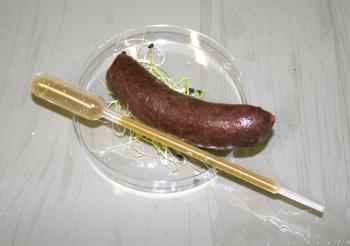
Blood sausage w/apple pipette on a bed of leek sprouts
Shortly after devouring the baby blood sausage with apple pipette, designated philosopher Dr. Michiel Korthals stated that it was not the job of ethicists to police technological progression. New technological ideas require new societal arrangements and neither ethics nor technology should have the upper hand. He called for the co-evolution of ethics and the technological object in question. Can’t say that I agree with him about that, looking back with 20/20 hindsight.
Korthals introduced the notion of scripts, or the use of future scenarios by scientists to imagine the effects of a given technological object as input in society, describing the utopian, optimsitic, pessimistic and most interesting, the ambivalent scripts associated with lab grown meat. He cited as an example how the pill divorced one of the more fun acts of sex from its causal relationship with pregnancy. Could lab meat or any other technologically produced foodstuff separate the culturally rich acts of eating and farming from the side effects associated with these acts? Korthals had no answers but was rather thorough in presenting all manner of scripts, one of which was a de-centralised production of lab meat, meaning home grown. Almost rhymes with home-cooked!
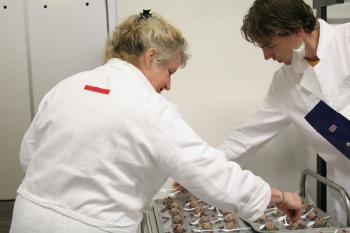
Queen of snacks, snack of Queens, rice and beans!
Last up was me moi-meme, who tried to bring a whole systems approach by way of a florid description of 1970’s California food subculture. I spoke about why it’s so difficult to see food as part of a very large system, defining whole food along the way. Because I’m good buddies with the food designers, I was hip to the menu beforehand and used the lineup to elaborate my response to the other speakers. Divided into four delicious snacks, the basic components of the menu were soybeans, bones, blood, rice & beans, and wheat meat. The edamame starter was a springboard for talking about techno-industrial vs. whole foods and that when soybeans cease to be soybeans, they have historically been cast as the ‘dictators’ choice’ in the firmament of utopian technofood. Coincidence?
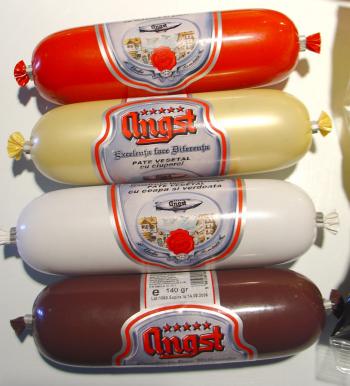
Will you be having the angst or the angst?
The bone and blood courses were an expression of the necessity to eat and enjoy the entire animal, from snout to tail. The three previous speakers cited statistics depicting the impact of livestock, neglecting to mention that those statistics change when we consider animal protein consumption as steaks, breasts and bellies. There’s more to meat than T&A.
The meat ball snack was in fact my plea for plain ‘ole rice & beans. What I find most vexing is that an entire technological trajectory and industrial process needs to be set up to produce a meat substitute. What’s wrong with rice and beans? That’s what most folks eat when they can’t, won’t or don’t eat meat. Depressing landuse statistics (1,4 ha/pp) refer to omnivorous practice, not vegetarian (as low as 0,2 ha/pp) or folks that occasionally tuck in. When even the highly conservative FAO can be clear about the environmental impact of livestock, why not wonder more about the ethics of entitlement?
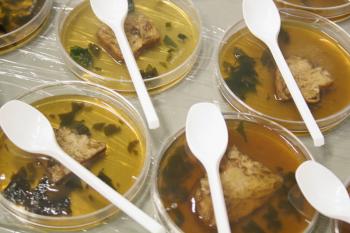
Seitan snack in agar agar aspic
My favourite menu item was the last, a thin slice of marinated seitan on agar agar aspic. As we had gathered to discuss this technological future food, with its resource-rich trajectory and not a shred of lab meat expected on the public plate before 2012 AD, I thought it only fair to point out that home protein production is very much right here, right now if you can just afford the initial investment of white flour, water and a bowl. In terms of protein, 100 grams of wheat meat weighs in at half a percentage point shy of cheese, but still 2 percentage points higher than red meat. I’m not sure about the protein capabilities of the projected lab meat, but I’m thinking that home grown protein is not so much in need of product development as process awareness. Amen.
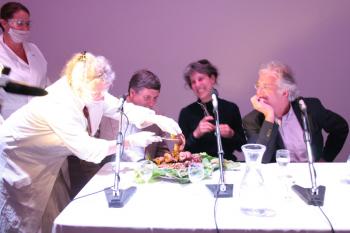
The panel gets an earful from Wandering Banquets. Click the image. Missing is Dr. Cor van der Weele.
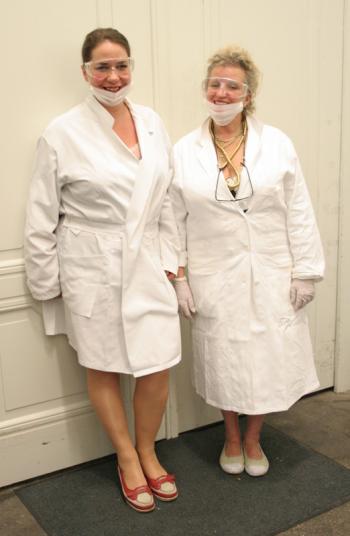
Wandering Banquets’ Overakker and de Jong
All photos in this entry are by Tomoko Take.
The Dutch slang word for lab grown meat is kweekvlees. Sounds like Quake Flace.
Links to pesky bits about meat and wheat meat:
- Culiblog on the ‘dictators’ choice’: Soy Story
- Culiblog on home protein production: Glutinous Maximus
- Culiblog on vegetarian subculture: Learning through your ass
- FAO Newsroom
On emissions: According to a new report published by the United Nations Food and Agriculture Organization, the livestock sector generates more greenhouse gas emissions as measured in CO2 equivalent - 18%, than the transport sector. It is also a major source of land and water degradation.
The livestock sector accounts for the following percentages of total emissions:
carbon dioxide - C02 - 9%
nitrous oxide - N20 - 65%
methane - CH4 - 37%
ammonia - NH3 - 64%On land use: 30% uses of the earth’s surface
33% of all global arable land is used to feed livestock
Meat and dairy animals account for 20% of the earth’s biomassGlobal meat production is projected to more than double from 229 million tonnes in 1999/2001 to 465 million tonnes in 2050, while milk output is set to climb from 580 to 1043 million tonnes.
- World Watch
On energy: Energy Consumption & Global Warming: It takes far more fossil-fuel energy to produce and transport meat than to deliver equivalent amounts of protein from plant sources. This heavy use of carbon-rich fuels also contributes significantly to the emissions of global-warming gases.
On land use: Food Productivity of Farmland: In the U.S., 56 million acres of land produce hay for livestock. Only 4 million acres produce vegetables for human consumption, reports the US Department of Commerce. Such inefficient use of land means that food production will not keep up with population growth. - Toronto Vegetarian Association
On land use: A meat-based diet requires 7 times more land than a plant-based diet. 0,2 ha (plant-based diet) vs. 1,4 ha
On efficiency: 6,2 k grain : 1 kilo animal protein (pigs 8,4, chicken 3,2) Most energy is spent on movement not weight gain.
40 kilos of shit : 1 kilo of edible beef
On energy use associated with meat-based diet: According to one study, meat production requires 10 to 20 times more energy per edible tonne than grain production.6 Growing feed crops requires extensive energy for ploughing, harvesting, pumping irrigation water, transportation, and producing fertilizer and pesticides. Once grown, the crops are processed using additional energy. Livestock travel an average of 600 kilometres (in North America). Animal products tend to require more energy for processing, packaging, and refrigeration than plant-based foods. In contrast, many vegetables, fruit, grains and tubers require no refrigeration and little or no processing. - Vegan Outreach (oh don’t be so judgemental)
On land use: A meat-based diet requires 7 times more land than a plant-based diet. The average agricultural land area in North America is 1.6 hectares per person (1.4 hectares after adjusting for the export of grain). Yet there are many countries in the world that use as little as 0.2 hectares (half acre) of farmland per person. These are the countries with plant-based diets.
On land degradation: Expansion of livestock, key factor in deforestation esp in Latin America. 70% of deforested land (in LA) is occupied by pastures and feedcrops (from FAO report)
On water use: 8% of global human water use for livestock (primarily irrigation of feedcrops)
On missions: 18% total emissions of C02 attributed to livestock = more than the transportation sector
On biodiversity: Leading driver in reduction of global biodiversity - Greenhouse gasses on our plate at Jean Marc Jancovici’s Manicore website
- Not while I’m eating, a study of human response to food as part of a system - by Axel Aubrun
- Michiel Korthals is author of the Dutch language book Voor het eten (Boom Publishers)
debra at 12:58 | | post to del.icio.us


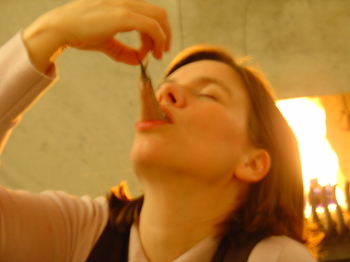
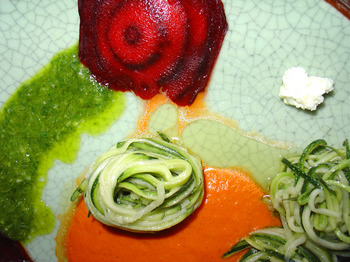

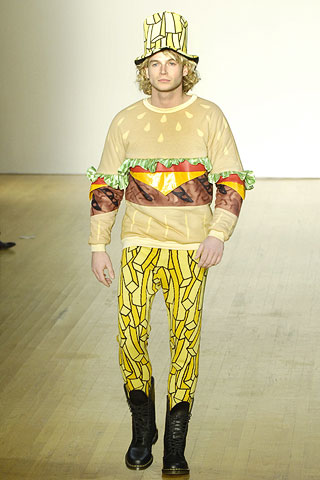
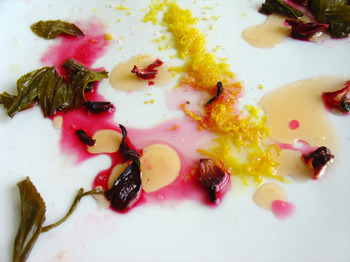
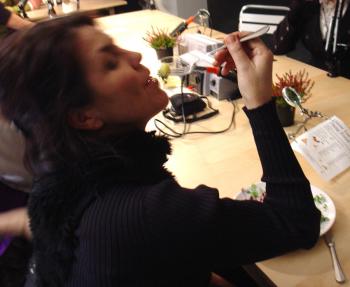
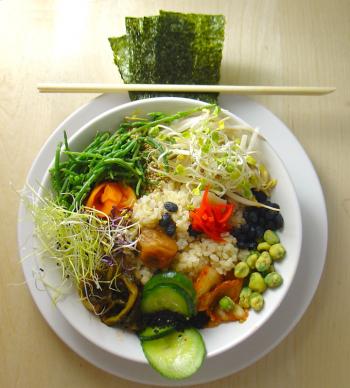










Hi Debra,
thanks… the nasturium leaf is very beautiful too though. I was glad to see that art was winning it from nature this time.
Excuse my English by the way, Dutch is more my thing.
I kind of knew you already , at least your face from the rietveld
Comment by Loraine — July 8, 2007 @ 11:52
We probably know eachother already then. Je mag ook NLands spreken op dit blog.
Welke afdeling?
Comment by debra — July 8, 2007 @ 12:31
o.. ik zat bij v.a.v. tot en met ‘99…
Comment by Loraine — July 9, 2007 @ 15:43
Everybody who has ever grown animal tissues in the lab knows that artificial lab grown meat is ridiculous. It wil always much cheaper and better to grow it in an animal. I could envision that this technology might be useful for people with inherited muscle deficiencies though.
Comment by Jurgen — July 23, 2007 @ 15:04